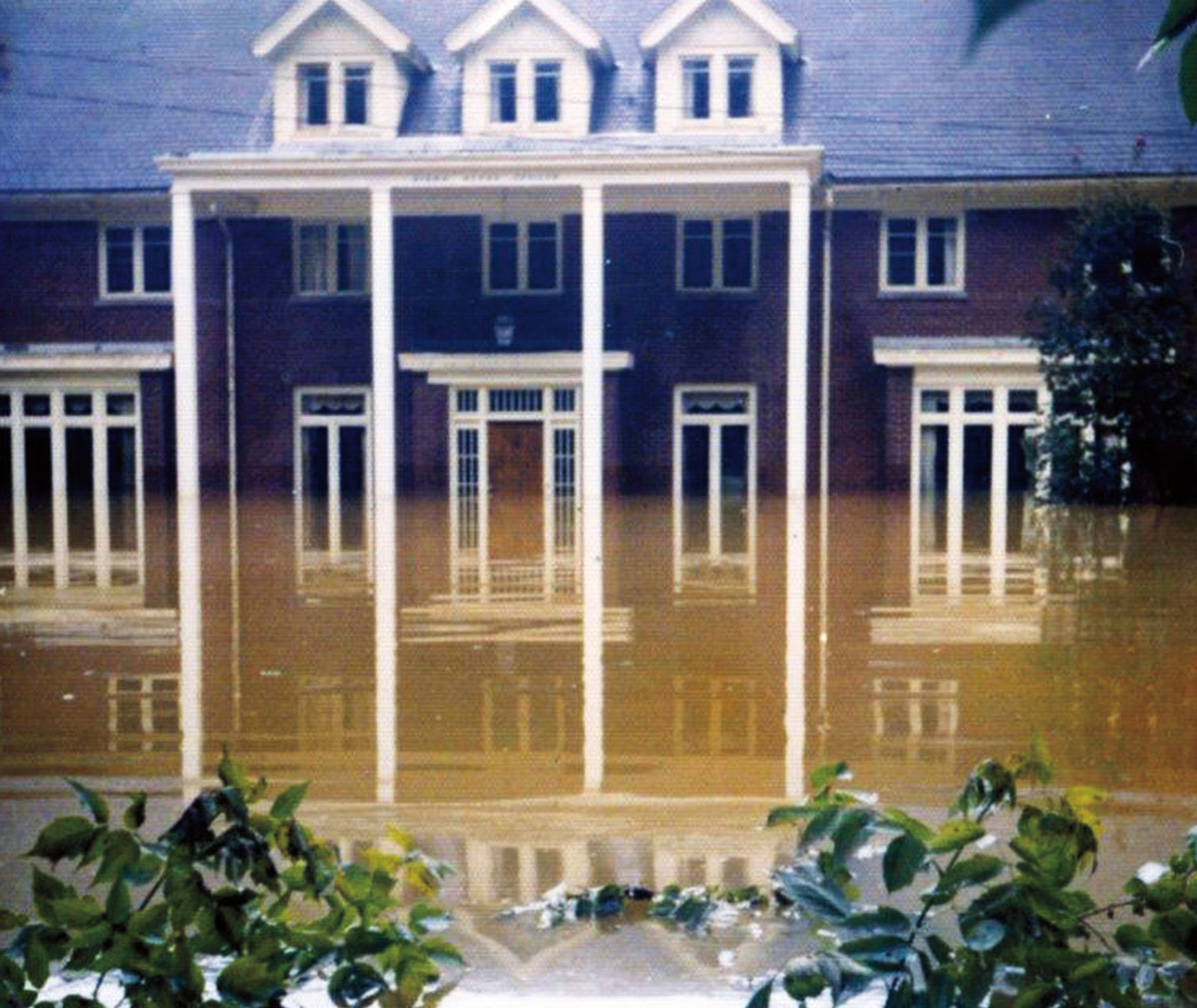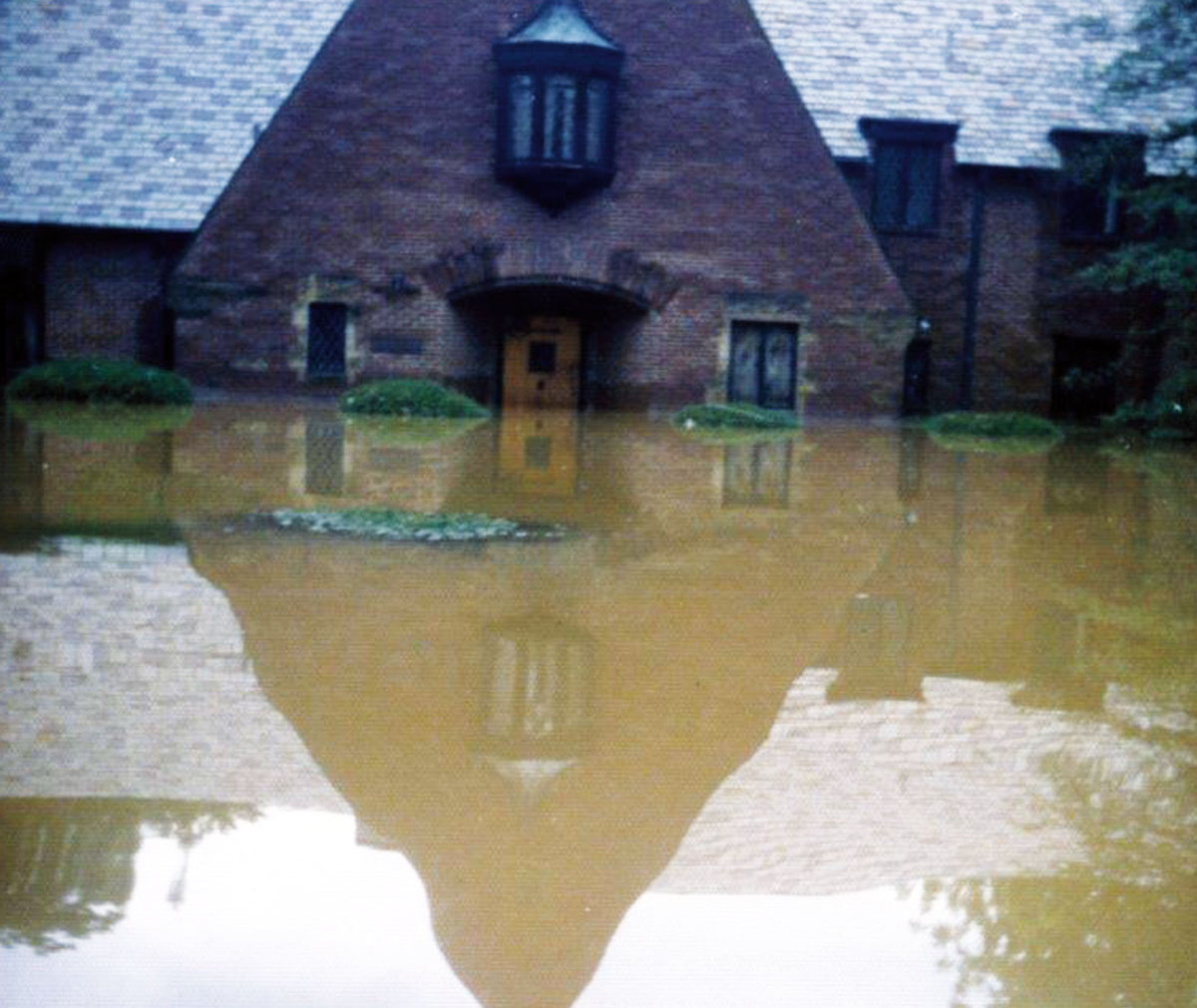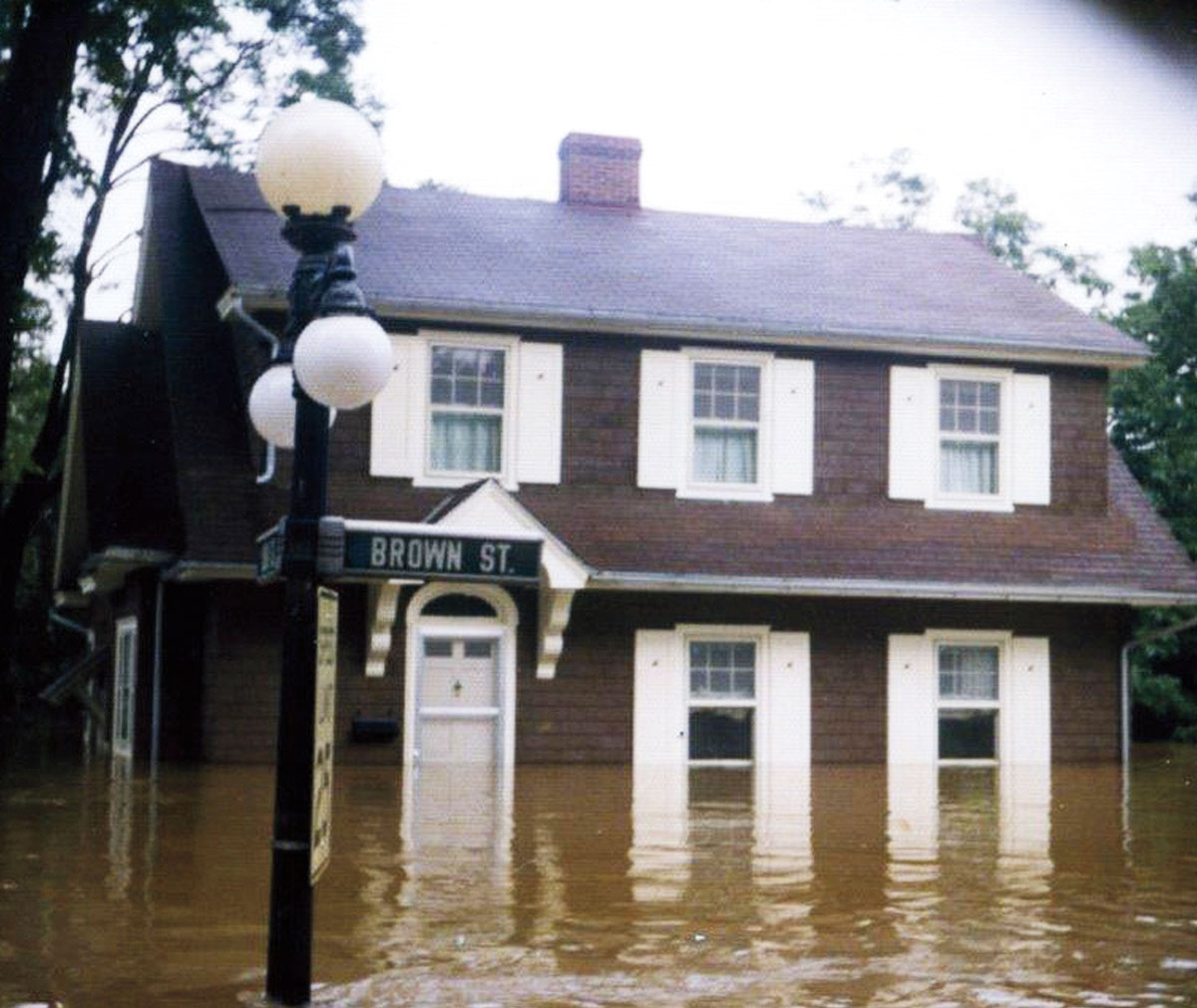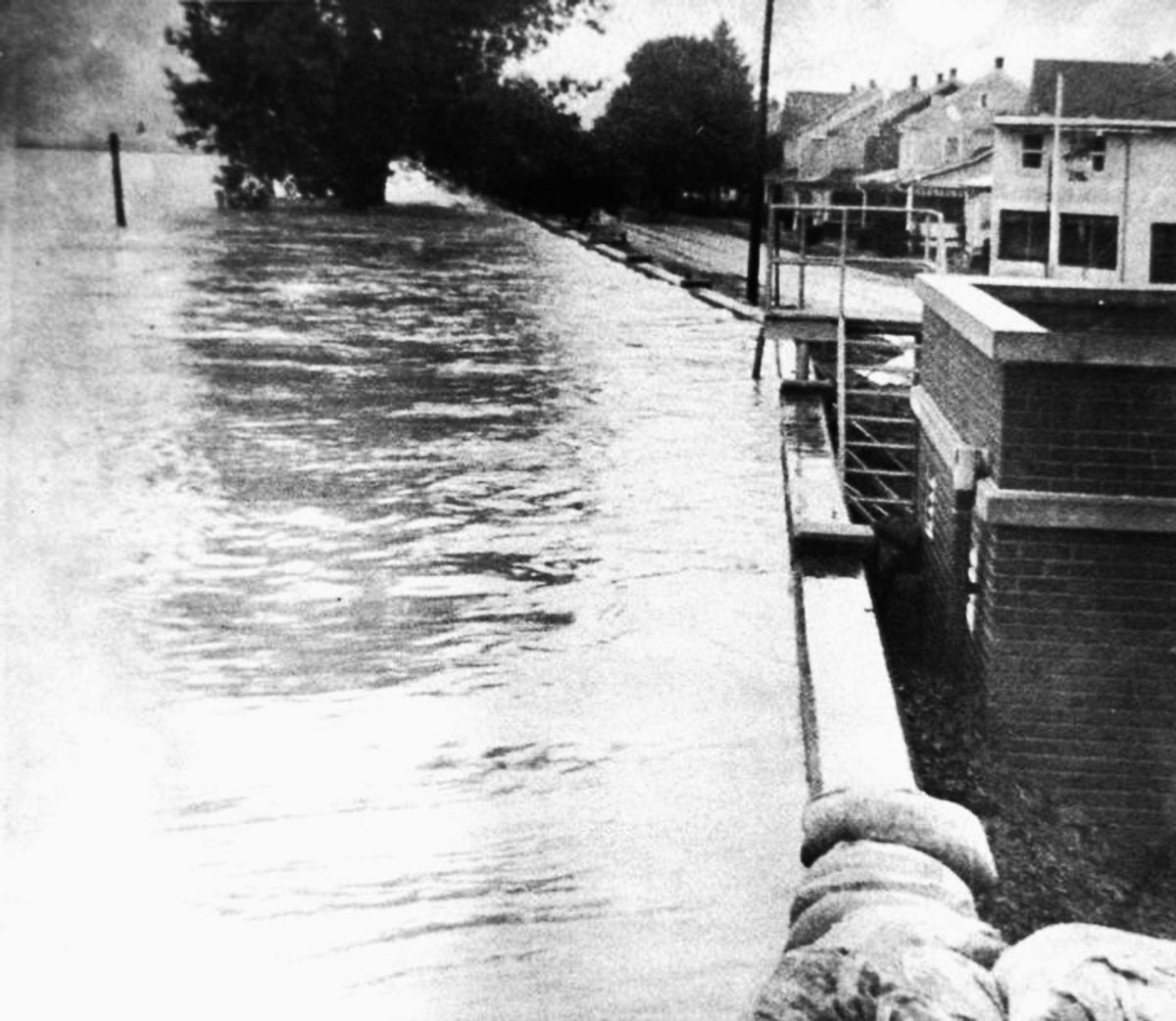A Flood of Memories

50 years later, the Bucknell community reflects on a deadly storm’s impact
Illustration by Matt Rota

“Before Agnes” and “After Agnes.” That’s how many longtime Lewisburg-area residents talk about their communities in the central Susquehanna Valley. History got split into two distinct eras. In 1972, massive floods spawned by Tropical Storm Agnes decimated the hearts of many river towns. The recovery has been long and arduous. Scars from Agnes and landmarks of resilience are visible if you know where to look.
In June, Bucknell and local communities will commemorate the 50th anniversary of Agnes. The storm killed at least 128 people in several states, including 48 Pennsylvanians. It destroyed 70,000 homes and left hundreds of thousands without electrical power, telephone service or clean drinking water. President Richard Nixon declared that it was “the greatest natural disaster in the history of the United States.”
“Before Agnes, people in Lewisburg and other river towns thought they were prepared because they did take precautions,” says Professor Andrew Stuhl, environmental studies & sciences. “If floodwaters collected in a location, they knew from experience to move their things out of harm’s way to the second floor or even evacuate their house. They thought it couldn’t get any worse than the flood of 1936, the most damaging one on record at that time.”
In March 1936, heavy downpours and melting winter snows flooded most of Lewisburg and other river communities.
But Agnes was worse — a lot worse.
On June 19, 1972, Hurricane Agnes hit the Florida panhandle and traveled up the Atlantic seaboard into the Chesapeake Bay. By then, Agnes had weakened to a tropical storm, but it met a cold front coming from the west and stalled over the Susquehanna River Valley.
Across eastern and central Pennsylvania, Agnes inundated historic downtowns, cut phone and electricity lines, collapsed bridges, burst or overran levees, broke road sections, uprooted trees, and tore homes and other structures from their foundations.
The storm dropped as much as 18 inches of rain on eastern Union County, where the Susquehanna River crested at more than 34 feet — 17 feet above the flood stage. Agnes caused about $300,000 in damage to Bucknell (approximately $2 million in 2022 dollars), although buildings on higher ground were untouched.
Most of Lewisburg was inundated. Before the storm, Robert Layton, an Agnes survivor, volunteered to help residents move their valuables out of harm’s way. “First, we started moving stuff out of basements and moving people upstairs. But some people refused to leave, then they were stranded on the second floor, and water was too far up into the first floor to get them out any other way than through a window.”
Two Lives Lost
Lewisburg Public Safety Director Gordon Hufnagle tried a last-minute rescue of a woman, but she lost her balance in the motorboat, which overturned, and the swift current swept them away to their deaths.
Some maps identify that section of the waterway as Limestone Run. “Locals know another name for the creek: Bull Run,” recalls Thomas Groninger, another Agnes survivor. “Heavy rains would transform this sleepy creek into a violent animal. The water would roar and thrash like a raging bull.”
Layton and Groninger were among more than 40 flood survivors interviewed by Bucknell students and faculty for Agnes Revisited, a 60-minute video performance that incorporates archival records, oral histories, Facebook posts and other materials into monologues, songs and visual storytelling. The scenes and images tell the story of the 1972 storm and recovery. The project covers Agnes’ impacts along 20 miles — from Milton, on the Susquehanna River’s West Branch, to Selinsgrove on the Main Branch.
In April 2021, Presidential Fellow Bethany Fitch ’23 and Stuhl presented Agnes Revisited on Zoom. Eleven community organizations co-sponsored the event, and the cast included Bucknell students, local leaders and Agnes survivors. In November, Fitch and Stuhl presented their research and portions of Agnes Revisited at Bucknell’s Elaine Langone Center during the 16th Annual Susquehanna River Symposium.
Fitch has spent two academic years studying the legacies of Agnes. “I’ve gained a deeper connection with the town where I go to college and the surrounding community,” says Fitch, an environmental studies and theatre double major. “It’s helped me understand how people interact with their environment, how they think about the river and how it affects their daily lives. It’s helped me understand how powerful water can be — and the power of stories. Stories speak to people more than facts do.”
Students in Visual Styles, a senior theatre design seminar taught by Professor Elaine Williams, theatre & dance, collaborated closely on Agnes Revisited with students from Stuhl’s environmental studies seminar.



“We had a multidisciplinary group of students that created puppetry theatre performances, in which you rely less on words and dialogue and more on music and the visual image to tell stories,” Williams says. “Visual storytelling in community-based performance has immense power to create greater environmental awareness.”
The Bucknell student and faculty team continues to delve into Agnes research and plan events. The Zoom performance will be the foundation for a book and potentially a tour of public performances in June, including a floating cruise along the Susquehanna River. The creators hope more survivors will step up to tell their stories, creating a richer narrative of Agnes and community resilience.
“We live in a place that Agnes helped shape,” Stuhl says. “After Agnes, as river towns decided how to redevelop, many realized that they should make more room for waterways and floods and reconsider how and where to build, and that process is ongoing.”
A Flood-prone Valley
Tommy Patten, an Agnes survivor, told Bucknell interviewers about his “Tom Sawyer” boyhood on the shallow, peaceful Susquehanna River.
“When I was 11 and 12 years old, every day in the summer, we were fishing and swimming, though the only place you could swim was between the two bridges in Lewisburg, where the water was deep enough,” Patten says. “We could camp out on the islands, pitch tents and sleep down there. It was a great upbringing with a sense of adventure. I knew the river really well.”
One theme threading through Agnes Revisited is the dual nature of the river.
“People we interviewed told us how they loved to spend time on the water, fishing, boating, just biking or walking by,” Stuhl says. “That forms a deep connection between us and the natural world. But there’s the threat of destruction from the river. How do you hold that tension between your love of the river and its threat? It can depend on your experience and whether you lived through a flood.”
For Professor Benjamin Hayes, director of the Bucknell Center for Sustainability & the Environment’s Watershed Sciences & Engineering Program, Agnes changed his life’s trajectory.
With schools closed because of flooding, Hayes and his brother explored areas around their family farm in Lancaster County.
“We were crossing a road, and the water was up to my kneecaps but moving at high velocity,” Hayes says. “I couldn’t see the edge of the pavement through the murky water, and when I stepped off it, I slipped in and went down. Although I was a swimmer, I got swept away. I remember being pulled underwater for what seemed like an eternity. It took me several hundred yards downstream until I was able to grab a tree and hold on. My brother was able to reach me, and he helped me out. I was baptized, if you will, by floodwaters, and I’ve been struck ever since by their power. I’ve spent my career studying floods and their impacts on rivers and streams, on fisheries and other biota [plant and animal life] and communities.”
A Living Laboratory
The Susquehanna River is a natural laboratory for scientists to study how waterways and modern settlements interact. The 444-mile Susquehanna is the longest river in the eastern United States and one of the most prone to flooding. Much of the river’s watershed is rugged and mountainous with upland streams swelling during heavy rains and racing down into valleys, overflowing rivers, tributaries and creeks.
Colonial towns grew up along the waterways — the major arteries of commerce. Settlers cleared forests for farms, and lumber companies harvested timber, floating logs down the river for shipbuilding and other industries. Grain mills prospered, shipping goods by canal boat to Baltimore and other destinations. As river towns expanded, people began to build homes and businesses in low areas. They filled in floodplains, dredged once-meandering tributaries, straightened and narrowed them, and lined banks with rock and concrete. Wetlands were lost to gravel mining, and farmers drained them to plant crops in rich bottomland soils.

By the early 1970s, many critical water-storage spaces — forests, wetlands and undeveloped floodplains — were lost, exposing the region to increased flooding, especially during the Atlantic hurricane season.
“In many ways, because of its topography, geology and location, central Pennsylvania is uniquely prone to flooding,” Hayes says. “If you plot all the hurricanes that hit North America over the last several hundred years, many of them come right up the Atlantic coast, just as Agnes did, and into the Chesapeake Bay and up the Susquehanna River.”
In 1999, Hurricane Dennis flooded Susquehanna River towns. Hurricane Ivan struck in 2004, Tropical Storm Lee wreaked havoc in 2011, Hurricane Sandy battered Pennsylvania and other states in 2012, and Hurricane Ida caused flash floods in 2021. But Agnes remains the most destructive of all.
Climate change has intensified many tropical cyclones around the world with higher peak wind speeds and more precipitation in those storms — and scientists say those trends are likely to continue in coming decades.
“As the climate changes, we’re getting more opportunities to bring in more water in storm systems of various types,” says Professor Emeritus Craig Kochel, geology. “We may find that the Agnes flood won’t be the No. 1 flooding event anymore.” Many localities have restricted development on floodplains. But urban growth at upstream locations in watersheds is adding more impervious surfaces such as roads and parking lots, which amplify surface runoff into streams and tributaries, increasing the potential for more extreme flooding downstream. “As watersheds become more developed, climate change combined with land-use changes could make the region even more vulnerable to flooding,” according to Kochel.
Communities Powered the Recovery
Before and after Agnes, volunteers poured into river towns to help.
Jeannette Lasansky, an author, community activist and wife of Professor Emeritus William Lasansky, art, told Bucknell oral-history interviewers: “As waters were rising and threatening homes, the local plain-sect community of Amish and Mennonite arrived with a big truck. They said, ‘Can we move things?’ and we said, ‘Yes.’ They scrawled our names on the refrigerator, our portable dishwasher and washer and dryer. We didn’t know where it was going. They just said, ‘Put it in.’ When the floodwaters receded days later, they returned and put [our appliances] just where they had been.”
Local churches and other institutions opened their doors to evacuees. Professor Emeritus William Becker, religious studies, recalls how his family found shelter near their flood-prone home in Lewisburg. “My wife and I and my parents slept on pew cushions in the Methodist Church and received meals from the Lutheran Church. We had friends who offered to take in our three young children because it would have been difficult having them live in a church.”
Many small towns struggled to activate their local civil-defense systems, and residents lost contact with official warnings and updates. Ken Hering, then an engineer at the Bucknell power plant, stepped up to manage the emergency radio system for the town of Milton.
Route 15, a major north-south highway in Pennsylvania, became impassable in places, and traffic was diverted to the Bucknell campus, mostly empty of students during summer break. For four days, the University sheltered more than 300 evacuees, stranded travelers and employees who could not reach their homes. Visitors initially took refuge in Davis Gymnasium, but officials worried that floodwaters would reach the substation supplying power to the building, so they were moved to Swartz Hall. Bucknell food-service staff provided thousands of meals until visitors could again travel safely.
As floodwaters rose, new transformers at the physical plant work area near the river were threatened. These expensive machines were needed to generate power during the fall semester and would require several months to replace if damaged. The University’s crane was not large enough to move them, but a local contractor provided the needed equipment. Floodwaters from the river crested just 4 feet short of sandbags protecting the power plant, which was built in 1947 at an elevation 5 feet above the crest of the 1936 flood.
After the water receded, river towns began the grim process of recovery, but teams of volunteers again returned to help. Lauri Young, an Agnes survivor and cast member in Agnes Revisited, recalls: “People were coming out of the woodwork. In the morning, buses would pull up to our street, and groups of people would get out with buckets, mops, brooms and shovels. People would come day after day to help us clean up. We didn’t even know their names.”
Bucknell faculty and staff pitched in. “I joined several friends in helping Sherm Doebler [’49, M’49] clean up an apartment building he owned that had several feet of water on the first floor,” recalls Brad Tufts, retired Bucknell associate athletic director. “There was mud in every nook and cranny.”
Says survivor Michael Bailey: “The water level slowly lowered, but it left behind mud. Everything was mud.”
Preventing the Next Flood
Pennsylvania towns with populations of 10,000 people or fewer suffered a total of more than $250 million in damage from Agnes ($1.6 billion in today’s dollars), and they desperately needed help to recover. The Pennsylvania Department of Community and Economic Development coordinated federal and state grants to help towns rebuild but also address the continuing flooding threat. Before municipalities could receive those grants, they were required to create floodplain ordinances to limit new construction in low-lying areas and enact other measures to mitigate risk.
Hayes and his Bucknell colleagues have studied how river towns were rebuilt. “Some bulldozed buildings and turned spaces into parking lots and built high-rise apartments outside of the 100-year floodplain,” Hayes says. “Some communities converted flooded spaces to community parks. But other municipalities did not shift their land use or change their zoning restrictions, and so people moved back in, and many have continued to suffer floods.”
Agnes cut out the hearts of many historic downtowns. “Businesses have moved out, so people don’t come downtown anymore, and communities have lost a lot of their tax base,” Hayes says. “Several of us at Bucknell have partnered with Robert Nicholas ’94, at Penn State’s Initiative for Resilient Communities, to address resilience and sustainability challenges such as those in Pennsylvania’s flood-prone riverine communities. This initiative provides opportunities for students to work on meaningful projects in river towns like Lewisburg and Selinsgrove.”
The question, Stuhl says, is whether river towns can continue to remember Agnes and further protect themselves against the next catastrophic flood.
“If you’re recommending that small towns convert land use from residences or businesses to public space to reduce flood damage, that’s taking a big part of their tax base, which forms the operating budgets of municipalities,” Stuhl says. “It’s difficult for towns to do that without having to raise taxes on everyone or becoming financially insolvent.”
Yet many Agnes survivors call on river towns to do more to protect lives and property from flooding, Stuhl says. “When we asked people what they learned from their Agnes experiences, they said, ‘Don’t build on the waterway. Give it space. Listen to the scientists.’ ”

environmental studies & sciences
Local officials and community organizations continue to educate residents about floodproofing their properties and applying for flood insurance. And a growing number of river towns are reorienting their economies by creating waterfront parks and other open spaces to attract visitors. “Many local projects over the past 15 years have received state and federal grants, recognizing the value of the river and reconnecting towns back to waterways,” says Stacy Richards ’78, a Union County commissioner. “That has led to a tourism boom.”
In Lewisburg, condemned buildings along Bull Run were purchased with federal buyout funds and demolished. Over many years, residents and Bucknell students have collaborated on efforts to restore sections of the tributary’s channel to a wider, meandering course. Hayes and Kochel co-taught a course in which the students used stream-gauge data to complete a comprehensive study of the Bull Run watershed.
Through Lewisburg Neighborhoods, a nonprofit organization, the borough of Lewisburg received $1.4 million in state grants to design and implement a new path section, nature-play area and flood-restoration project at Hufnagle Park, to be completed in June. The path is an extension of the Buffalo Valley Rail Trail to the Bucknell campus. On June 24, Hufnagle Park, named to honor Officer Gordon Hufnagle who died during Agnes, will be the venue for the town’s 50th-anniversary commemoration with a showing of Agnes Revisited.
The park has become a memory touchstone for Bucknell students and others who participated in the Agnes Revisited project. Clare McGowan ’21, an environmental studies and history double major, says, “Even though I’d lived in Lewisburg for four years in college and I’d walked by Hufnagle Park many times, I had no idea how significant the area was. I had an opportunity to learn from people who lived through these historic events. The Agnes survivors’ memories and personal stories helped me understand and reflect on what happened in 1972.”
This semester, Stuhl is teaching a course on Susquehanna history. “We will explore how communities such as Lewisburg managed to reduce the flood threat by converting some of their floodplains to public spaces,” Stuhl says. “We will look at the efforts of many people in the aftermath of Agnes who contributed to these success stories. They were not the responsibility of just one elected mayor or council person but the result of years of community dialogue and democracy.”